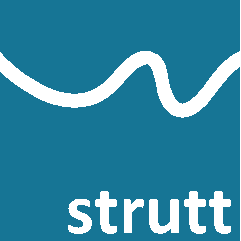
Strutt Help
Auditory Masking
1/1, 1/3
Strutt|Electroacoustics|Auditory Masking allows the user to calculate the masked threshold for auditory masking from a noise spectrum.
Two methods are available in Strutt:
The ISO7731 method assumes a constant slope of masking of -7.5 dB/octave and calculates the masked threshold for each frequency band as follows:
For the lowest frequency band: `L_(T,i)=L(N,i)`
For all other frequency bands: `L_(T,i)=Max(L_(N,i),L_(T,i-1)+K)`
where:
`L_(T,i)` is the masked threshold in frequency band in question
`L_(T,i-1)` is the masked threshold of the previous frequency band
`L_(N,i)` is the noise spectrum level in the frequency band in question
`K` is the slope of masking:
- -7.5 dB/band for octave band analysis
- -2.5 dB/band for 1/3 octave band analysis
Note that ISO7731 allows for masking to "cascade" across multiple frequency bands - i.e.low-frequency noise can, if sufficiently loud, cause masking effects to extend over more than one adjacent frequency band.
Strutt implements a modified version of the IEC 60268-16 masking method. The key differences are:
- Strutt allows for masking to be calculated in 1/3 octaves; the original only includes 1/1 octave analysis. Strutt assumes that the 1/3 octave slope of masking is one third of the octave band slope of masking.
- Strutt allows for masking to 'cascade' across multiple bands (as per ISO7731); IEC 60268-16 assumes that masking effects will only impact one adjacent band.
In effect, Strutt is implementing the ISO7731 masking model except using IEC 60268-16 to calculate the slope of masking.
Hence, the equations used are the same as for ISO7731 (above) , except that the slope of masking K is level-dependent as follows:
- `L_(n,i-1)le 55; K_(oct)=-40`
- `56 < L_(n,i-1) le 65; K_(oct)=-35`
- `66 < L_(n,i-1) le 75; K_(oct)=-25`
- `76 < L_(n,i-1) le 85; K_(oct)=-20`
- `86 < L_(n,i-1) le 95; K_(oct)=-15`
- `L_(n,i-1) > 95; K_(oct)=-10`
For 1/3 octave analysis, the slope `K_(1//3" oct")=K_(oct)/3`
Note that the slope of masking in IEC 60268-16 is steeper (i.e. masking is less strong) than ISO7731.
References:
- ISO 7731 (2003) Ergonomics - Danger signals for public and work areas - Auditory danger signals
- IEC 60268-16 (2003) Sound system equipment - Part 16: Objective rating of speech intelligibility by speech transmission index
Comments or suggestions to
strutt@arup.com
